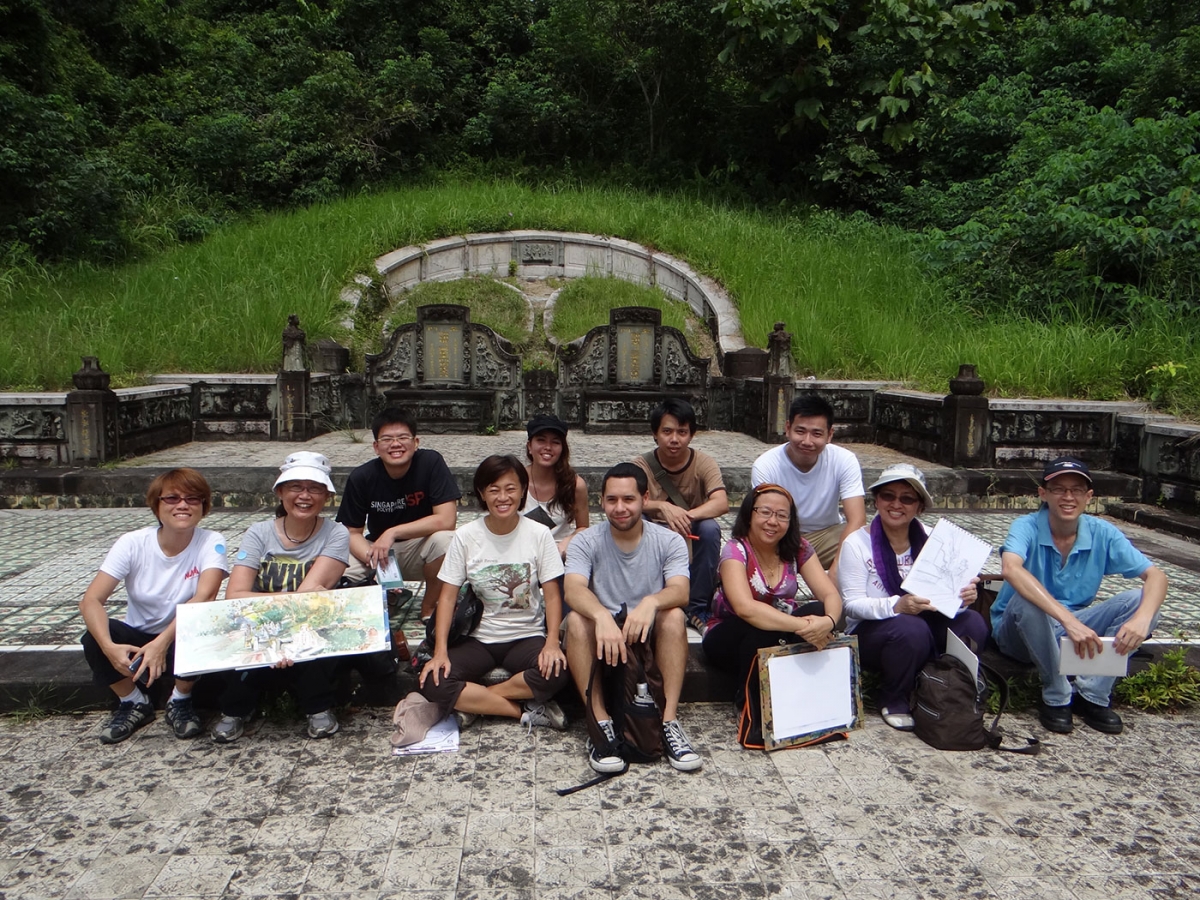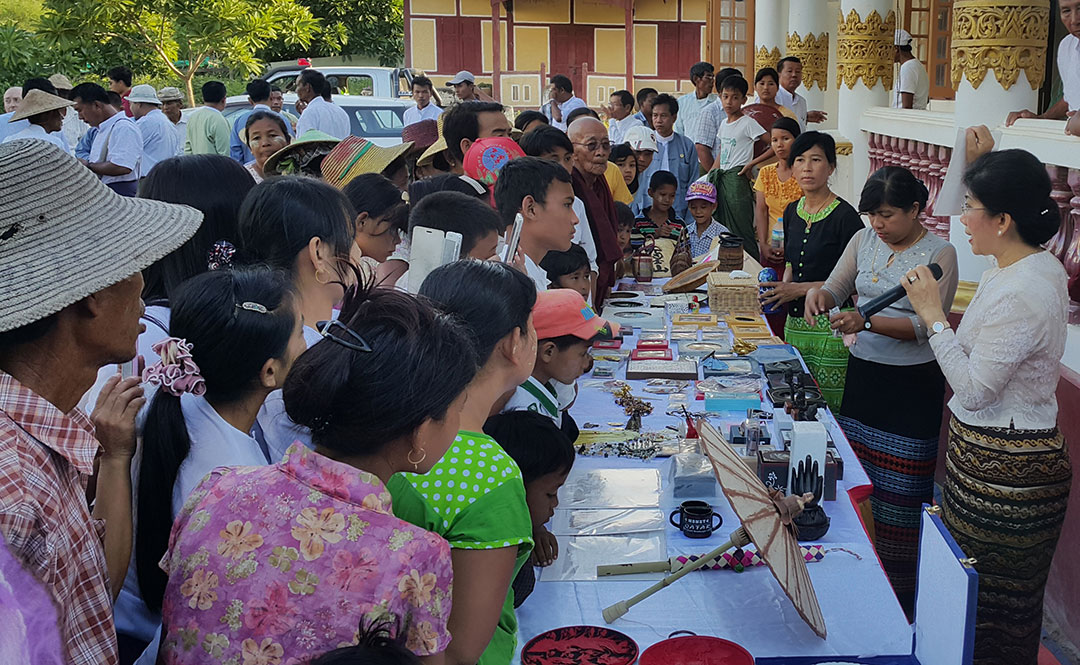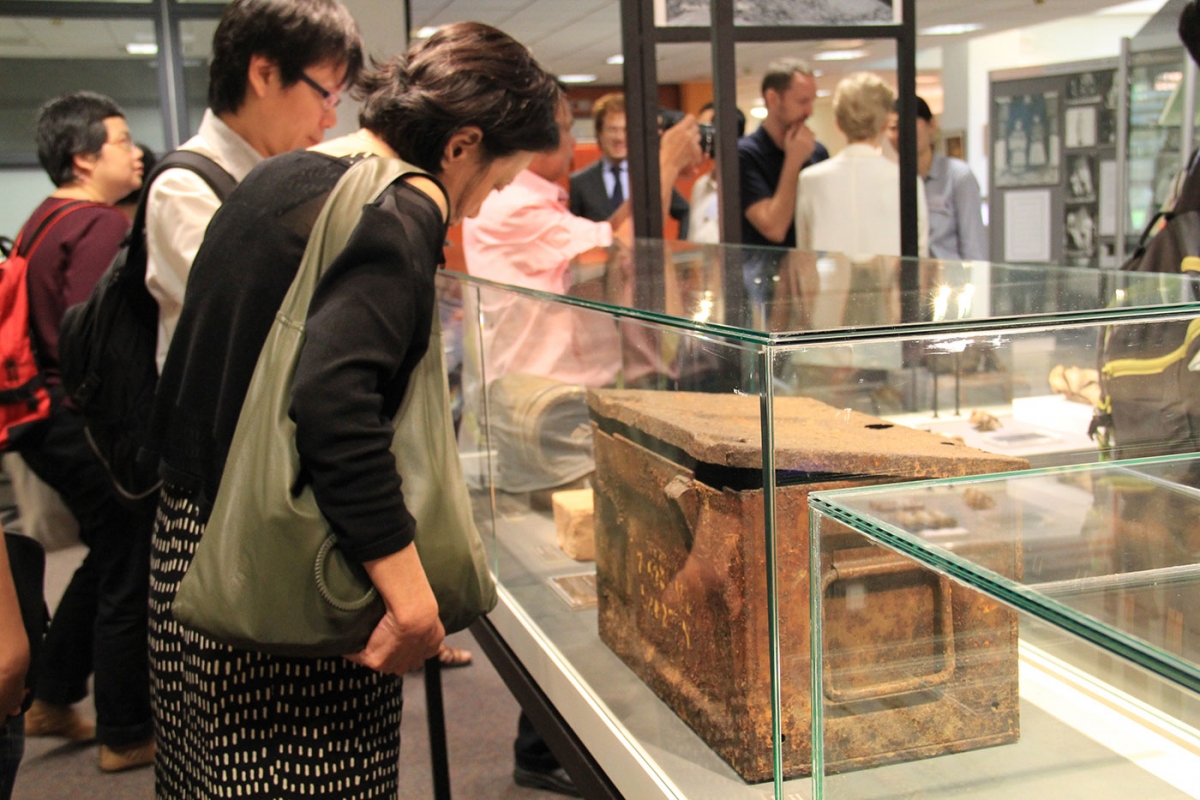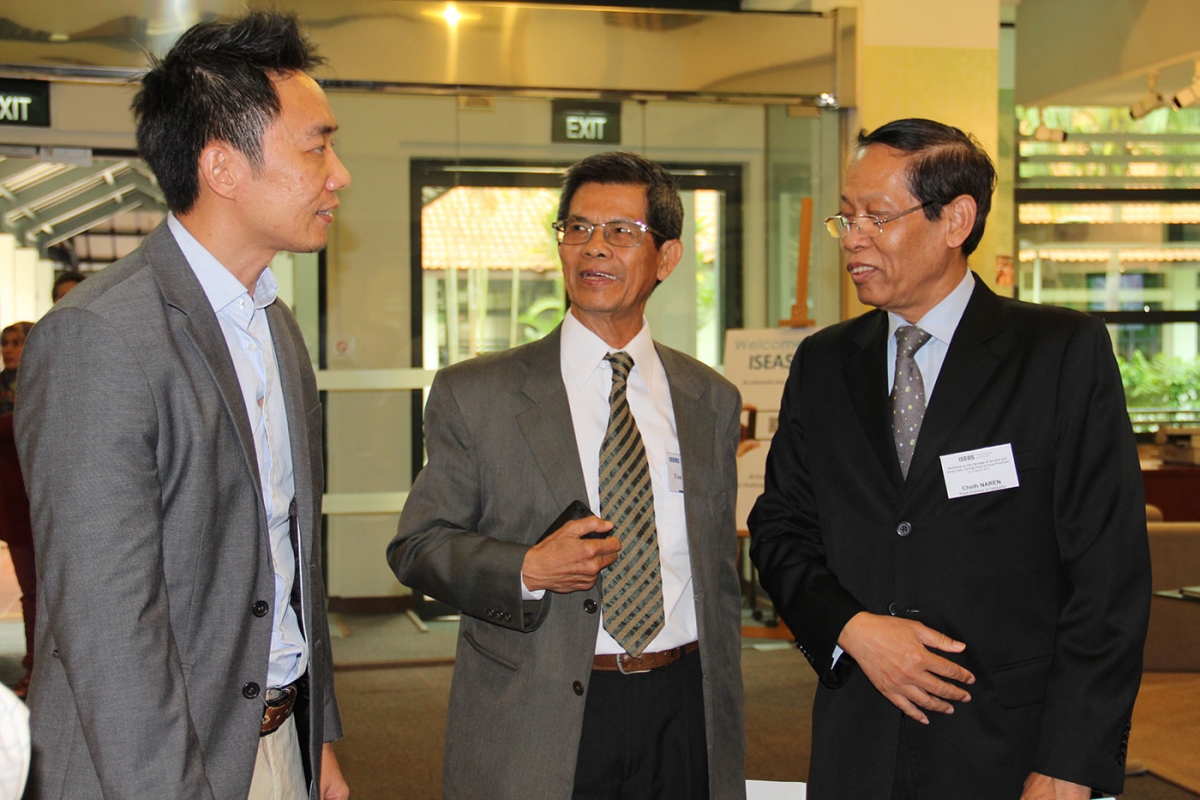Workshop on the heritage of ancient and urban sites: giving voice to local priorities
<p>The <em>Workshop on the Heritage of Ancient and Urban Sites</em> sought to unravel the complex politics involved in the manufacturing of heritage. To understand how stake-holders from across Southeast Asia define and voice local priorities, twenty-two cultural heritage practitioners based in Cambodia, Indonesia, Malaysia, Myanmar, Singapore and Thailand were invited to explain their projects. The successes – and impasses – they presented were part of their personal stories as they sought to make a difference in their communities. The need for education and collaboration was voiced by all: through education, communities come to care and with communication, grassroots and policymakers are, if not on the same track, at least aware that the other exists. And while most literature frames ‘grassroots’ as opposition and lobbying against authorities, our speakers evoked a far more intimate interchange between different levels of society. They spoke of impasses but also of exchange and negotiation.</p>
Education
In championing education to generate heritage awareness, the speakers were not lobbying for changes to formal teaching curriculums. While in some cases this has happened, the majority of classrooms described during the workshop were at ancient temples or in city streets. Heritage learning and teaching takes place beyond classrooms, often led by those with no formal degrees but in-depth local knowledge. The diverse ways this is being done is demonstrated in the following examples:
- HE Tan Boun Suy, Deputy Director General, APSARA-Authority, Cambodia discussed enhancement of traditional community agricultural practices within the Angkor Park to engage the eighty percent of the park population that are farmers.
- In Sumatra, Mr. Mukhtar Hadi has established the Muara Jambi Great Nature School (Sekolah Alam Raya Muara Jambi) using non-formal methods outdoors in the temple areas.
- At Lenggong Valley, Mr Mohd Syahrin Abdullah, Ministry of Culture Malaysia has constructed a World Heritage Trail to educate visitors on the archaeological landscape.
- Mr. Dwi Cahyono, Chairman, The Association of Indonesian Museum, East Java and the Malang Heritage Inggil Association, has published a history of Malang in comic-strip format, opened a restaurant cum archaeology museum (a “museum-resto”) and holds an annual festival for the citizens of Malang. Called Tempo Doeloe (“good old times”), annual themes have included the Malang coat of arms and the stories of Panji.
- Dr Hui Yew-Foong, ISEAS - Yusof Ishak Institute and Research Associate Professor with the Hong Kong Shue Yan University, showed how community engagement generated new discoveries on family lineages during documentation of the Bukit Brown Cemetery.
- Mr. Lim Chen Sian Nalanda-Sriwijaya Centre, ISEAS - Yusof Ishak Institute, showcased the benefits – and drawbacks – of volunteers in rescue excavations beneath the streets of Singapore.
- Dr Nigel Taylor, Director of the Singapore Botanic Gardens, profiled Lawrence (Laurence) Niven (1826-1876) who laid out the future Singapore Botanic Gardens in a manner akin to the 18th century British Victorian parks, and Henry “Rubber” Ridley who directed the gardens from 1888-1912 during which time (1877) rubber plants arrived from Kew Gardens in England.
All these examples, and indeed, the entire workshop, showcased the incentives taken by different projects to educate and motivate local communities.
Another common point was the importance of intermediary voice holders categorized as ‘passeurs’ in the presentation of Mrs. Pijika Pumketkao-Lecourt.1 These individuals do not necessarily derive from or represent grassroots communities or state institutions. Rather, passeurs act as liaisons and transmitters to find common ground between dissimilar parties. This concept successfully bridged a divide between the senior abbot and local residents on the restoration of the nineteenth century CE Viharn Phra Chao Pun Ong at Pongsanuk in Lanna. In 2004, a local art historian initiated a dialogue that began with raising community awareness and research.2 Conservation was completed in 2007 following Lanna traditional norms. Equally important was revitalising community cooperation in the maintenance and repair of religious structures.3
Two speakers from Cambodia highlighted how education needed to be the first step.
- Dr Ea Darith stressed how during the 2015 Koh Ker International Field School with the Nalanda-Sriwijaya Centre, ISEAS - Yusof Ishak Institute stake-holders were first defined. They came from village and commune leaders, government offices, and religious organizations and the APSARA-Authority who employs almost 100 local people to safeguard, maintain, and clean the site.
- Associate Professor Dr Surat Lertlum from Thailand and Mr Im Sokrithy from APSARA-Authority Cambodia showcased education in the transnational Living Angkor Road Project (LARP) to the Cultural Relationship Study of Mainland Southeast Asia Research Center (CRMA). The LARP/CRMA team actively uses the results of the partnership to educate and involve high school students in Cambodia and Thailand in classrooms and in the field at sites in both countries.
As in the Lanna temple restoration project, Assistant Professor Dr Kang Shua, Singapore University of Technology and Design, described the changing norms of architectural conservation of Chinese temples, from a ‘3R Principle’ of ‘Maximum Retention, Sensitive Restoration and Careful Repair’ to a nuanced relativist approach that appreciates the temple as a living monument able to function for religious and non-religious groups.
Collaboration: grassroots, municipal and national institutions, and international organisations
While positive government-community communication was seen in Myanmar and Cambodian heritage, many instances were voiced where strong government control hobbled the sustainable relationships with grassroots organisations.
- This lack of coordination was apparent in mining threats to the 7-14th century CE site of Muara Jambi presented by Mr Mukhtar Hadi (Perkumpulan Padmasana Association, Jambi).
- Mr Phon Kaseka, Royal Academy of Cambodia, showed how ancient kiln complexes and other archaeological sites are being systematically and rapidly destroyed at Cheung Ek in Phnom Penh’s fast developing peri-urban area. The Ministry of Culture and Fine Arts (MoCFA) seeks to research and protect while other ministries are tasked to increase land value and productivity.
Democratisation and decentralisation were proffered to empower conservation initiatives from civil society. In Thailand, the decentralisation policy adopted by the Thai constitution of 1997 has strengthened local community-led engagement. Ms Mizuho Ikeda, Waseda University, in showing the ups and downs of a community-led group in Phrae to bring intangible beliefs to the attention of excavation officials, offered the model of Hagi-shi where urban heritage begins with local stories linked to tangible evidence. In Malaysia, government initiatives date to the 1960s, but it was more than two decades until local grassroots organisations, such as the Penang Heritage Trust (1986) profiled by Khoo Salma Nasution, arose. Speakers in the workshop also cited recent studies indicating that local stakeholders do not openly voice their interest in heritage to authorities at the UNESCO World Heritage site of “Melaka and George Town, Historic Cities of the Straits of Malacca” (http://whc.unesco.org/en/list/1223; inscribed 2008). The studies also have noted gaps between how communities and authorities define the value of the UNESCO site of the “Archaeological Heritage of the Lenggong Valley” (http://whc.unesco.org/en/list/1396; inscribed 2012).
In Indonesia it has only been from 1998 decentralisation that activities have increased despite the 1992 enactment of the Cultural Heritage Preservation Law (UUBCB) and the earlier rise of grassroots organisations such as the 1995 Preservation Team founded in Malang by Mr. Dwi Cahyono. On an optimistic note, Mr Punto Wijayanto showed how the Ministry of Public Works collaborated with grassroots in the Heritage City Conservation programme joined by 57 cities since 2008. He also showed that the grassroots term “Pusaka” instead of “Warisan” is now being adopted by State institutions. All three Indonesian speakers reminded the audience that initiatives emerged only after about 50 years following independence during which time, ancient sites were looted and old city buildings destroyed, especially following the 1970’s economic boom.
Governmental change has also impacted on heritage awareness in Singapore and Myanmar. In Singapore, since the 2011 elections, the ruling party has started to pay further attention to civil society’s expectations for more heritage preservation demonstrated by increased archaeological excavations, religious-civil dialogues on temple conservation and documentation of family heritage through work at the Bukit Brown Cemetery. In Myanmar, subsequent to 2010 elections, the government initiated the serial nomination of three early first millennium CE Buddhist Pyu sites to the UNESCO World Heritage list. During the process of inscription, the Department of Archaeology actively engaged the rural populations of the Pyu Ancient Cities, and worked with local stakeholders to form the heritage trusts. In a country where the caretakers of heritage have been the Buddhist Sangha and lay pagoda trustee committees for two thousand years, the new civil associations were a remarkable development.
The changes have brought threats as well, as explained by Ms Ohnmar Myo from the UNESCO Cultural Office, Yangon. She profiled post-inscription support to address increasing pressures on the Pyu Ancient Cities and Bagan stemming from recent development in tourism infrastructure, urban encroachment, newly mechanized farming methods and a rise in the construction of religious facilities linked to the ancient monuments. In contrast to the traditional care of religious structures in Myanmar, there has been little awareness of the value of civil or residential architecture in cities of the last one hundred and fifty years. As presented by Prof Dr Su Su (Mandalay Technological University), heritage inventories prepared by the Department of Architecture, Mandalay Technological University and Department of Urban and Housing Development, Ministry of Construction in 2015 have laid the groundwork for heritage zoning of Mandalay, Pyin Oo Lwin and Bagan, and an urban plan was adopted by municipal authorities for Yangon in 2014. Much is has been underway during the last five years.
Conclusion
Local heritage voices are now being heard across Southeast Asia, but they are remarkably new. The workshop speakers did not link themselves to heritage groups of the 19th or early 20th century, with Dr Nigel Taylor’s presentation an exception in connecting today’s UNESCO World Heritage Singapore Botanic Gardens to the 19th century founders. The rest of the speakers began their history with new organisations and laws of the late 1980s. Notably, this is also the time that art historians divide modern from contemporary art, separating the beginnings from the later post-modern experimentation. It is also the period during which the first sites from Southeast Asia were inscribed on the World Heritage List (Ayutthaya and Sukhothai 1991, Borobudur and Prambanan 1991, Angkor 1992).4 Local voices began to assemble in the 1990s, go through phases of experimentation and often failure, and since 2005, consolidate and mature. A regional paradigm still in the process of emerging, sees local community and grassroots organisations as normal players in the heritage domain. Their role as educators and interlocutors is often contested by academics, and rarely is written up in scholarly articles: they are actively educating rather than writing about their work. With the young, who will newly define cultural heritage, they are a highly valued window into another world. The ways local heritage practitioners have learned to spark and sustain commitment from youth and elderly are many: history books laid out in graphic comic-book strips, fairs in the city streets and offering lunchtime meals for monks. These and more activities are promoted though social media, the prime medium of communication to forge a sense of community within a space of shared heritage.
Statement of the Rapporteurs
Six Rapporteurs were selected from the younger members of each panel: Dr Goh Hsiao Mei from Malaysia who reported on the Indonesia panel, Mr. Lim Chen Sian from Singapore for Thailand, Prof Dr Su Su from Myanmar for Cambodia, Dr Ea Darith from Cambodia for Singapore, Ms Mizuho Ikeda from Japan/Thailand panel for Myanmar panel, and Mr Punto Wiyayanto from Indonesia for Malaysia.
Mr Punto Wijayanto also presented a drafted Rapporteur Statement to highlight three common concerns:
Financial sustainability
Financial issues are raised mostly by heritage organisations, but the public sector also raises this question. Is funding really the problem? For example, Singapore has ample financial ability, although this State doesn’t have a proper budget for heritage conservation. In the case of Malang, Heritage organisations can still work without funding or even with self-funding. Heritage organisations can find creative ways such as crowd-funding, as was shown by Dr Goh Hsaio Mei from the Center for Global Archaeological Research, Universiti Sains Malaysia (USM). In short, funding is a prime issue but money does not mean the community will care about the heritage of our sites.
Encouraging collaboration
More crucial is the need to integrate and make connections between government and grassroots to create a balance between different actors and their authorities. Governments can’t work alone. Myanmar’s process of World heritage nomination shows that the government can in certain circumstances appreciate the importance of community engagement.
However, in many or most cases, governments as the key actor only focus on the national significance of heritage, less on the community significance and use. In addition governments generally are limited in terms of manpower or funding. However, when government budget, action and law enforcement are absent, academics, professionals and heritage-lovers manage to work with local communities to promote their vision of heritage. This situation created alternative roles to discuss formal legal and local mechanism that we heard many speak of during the workshop. These roles and the individuals that fill them in French have been called the transmitters or passeurs. We heard this in the “Little People in Conservation” case of Lampang project in Thailand, where a local art historian successfully mediated with monks to safeguard the architectural heritage of a Buddhist temple. In Singapore, the passeurs have been called ‘citizen historians’, and they were the ones who primarily documented every detail of every object from the graves exhumed from the Bukit Brown cemetery slated for an urban development project.
Other speakers raised the issue of sustainability; all agreed that a heritage project needs the engagement of the community who feel a sense of ownership. Sites and artefacts need to be maintained over not just days or months, but many years. Education and the integration of heritage related events in public spaces are key factors, although this requires perseverance, as seen with the long transnational collaboration of ‘The Living Angkor Road’ (LARP) and the ‘Cultural Relationship Study of Mainland Southeast Asia Research Centre’ (CRMA), started by Dr Surat Lertlum and Mr Im Sokrithy.
Local meanings of heritage
During the presentations, all speakers used the word ‘heritage’, but actually understood and applied the notion to different situations and contexts. Defining heritage to encompass all stakeholder perceptions as well as the nature and intensity or degree of ‘value’ they attach to a particular heritage asset (tangible or intangible), has long been a problem. It is clearly an issue of ongoing concern, as the Rapporteurs’ point on this was followed by discussion both inside and outside of the conference rooms. Singapore uses the word ‘heritage’, for example, but in Indonesia two words – ‘warisan’ and ‘pusaka’ – exist. In Malaysia, only the word ‘warisan’ is recognised and in Thailand, ‘Moradok’ is used to translate heritage. We are left with the question for future workshops of how each of these words sustain local commitment to their community heritage.
The NSC Archaeology Unit Gallery in the ISEAS - Yusof Ishak Institute Library
The Workshop also saw the opening of the NSC Archaeology Unit Gallery. Established in 2010 under the Nalanda-Sriwijaya Centre (NSC), the Archaeology Unit (AU) was officially inaugurated by the 6th President of Singapore, SR Nathan, on 23 August 2011. The Archaeology Unit purses projects in Singapore and in Southeast Asia to enhance understanding of the region’s civilisations and their cross-fertilisation through the study of material record and archaeological evaluations. The AU also conducts rescue excavations, post-excavation analyses, public lectures, and artefact management.
The NSC Archaeology Unit Gallery showcasing the Archaeology Unit's excavations and projects in Singapore and Southeast Asia was opened during the workshop “The Heritage of Ancient and Urban Sites: Giving Voices to Local Priorities” by H.E. Tan Boun Suy, Deputy Director General APSARA-Authority. The Cambodian Ambassador to Singapore, H.E. Cheth Naren, officially unveiled the exhibition. H.E. Tan Boun Suy’s opening remarks:
We are honoured to be part of the ISEAS-YII library display opening. Our cooperative projects and Field Schools with Singapore and ISEAS-YII, NSC have been highly successful. They necessitate and promote local community inclusion and local voice – very much the theme of this conference. They also serve as a successful example of regional cooperation involving ASEAN and EAS countries, especially the recent Field School at Koh Ker.
As representatives of ASEAN countries here, I am confident all of us can build more partnership projects and successes; further strengthening meaningful, peaceful, and goal-oriented integration through our shared interests and respect for heritage and all concerned stakeholders, especially local communities. Their voices are not just important for each of our countries individually, but all of our countries together; important for all of ASEAN and beyond.
The gallery features a range of archaeological finds ranging from ancient Singapore in the 14th century to the British colonial period in the 19th century and the Second World War. Also on display are artefacts from the Archaeology Unit Field School and research projects in Cambodia.
Dr Elizabeth Moore, Visiting Senior Fellow, NSC (Elizabeth_moore@iseas.edu.sg)
Dr Terence Chong, Head of NSC (terencechong@iseas.edu.sg)
Dr Helene Njoto, Visiting Fellow, NSC (Helene_njoto@iseas.edu.sg)
Dr Kyle Latinis, Visiting Fellow, NSC (david_kyle_latinis@iseas.edu.sg)



